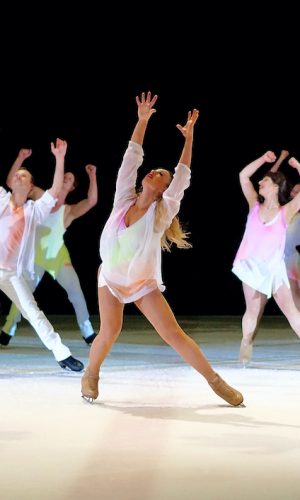[This article appears in the January/February 2020 issue of Boston Spirit magazine. Subscribe for free today.]
Editor’s Note: You can catch a performance of Ice Dance International tonight, at 7:30 p.m., at The Skating Club of Boston. For tickets ($20) go to IDI’s performances page on their website, where you’ll find more New England performances through March, and beyond. For more, read on:
When New Hampshire native and former professional ice skater Douglas Webster choreographs the company of professional skaters in his Kittery, Maine-based Ice Dance International (IDI), he is never alone.
“We lost so many people who were motivated to do what we do. John Curry, Robert Wagenhoffer, many of the Skating Club of Boston group, my dear friend Brian Wright, Shaun McGill—the list goes on of people who were friends who died of AIDS. I still talk to them; I still hear them and feel their guidance and protective spirit throughout the work we’re doing,” says Webster, the founder and executive artistic director of IDI. “We lost a whole generation who would be doing what I’m doing. I feel responsible to continue that legacy of what John [Curry] set out to do.”
Olympic champion Curry, the British skating icon who died of AIDS in 1994, was noted for combining ballet and modern dance into his skating routines. He later founded two ice dance companies that collaborated with modern dance choreographers such as Twyla Tharp. Webster remembers what a transformative experience it was to see Curry’s company perform. Not only did Webster achieve his own recognition as a young skater growing up in North Conway, New Hampshire, he served in the early ’90s as artistic director of Ice Theater of New York, which Curry founded.

Fast forward to 2014 and Webster, after leaving New York and settling in Kittery, launched IDI with the mission to “elevate sport to art” and to showcase the work of professional skaters and acclaimed choreographers. Besides Webster, IDI’s choreographers include American Trey McIntyre, whose company often performs in Boston and at Jacob’s Pillow Dance Festival, and France’s former competitive ice dancer Benoit Richaud who has worked with current top skaters Bradie Tennell, Jeremy Abbott and Daisuke Honda.
Webster credits productions such as Disney on Ice and Holiday on Ice, both with which he’s worked as a choreographer, for being an entree into ice dancing for young audiences. But with IDI, he wanted to continue Curry’s mission of showcasing the athleticism and artistry of ice dancing beyond family entertainment. Last year, IDI premiered a new work (on synthetic ice) at the Jacob’s Pillow Dance Festival; the company has also headlined at Aspen Gay Ski Week, Fenway Park, The National Baseball Hall of Fame, the Fenimore Museum, Rockefeller Center and the Strawberry Banke Museum in Portsmouth, New Hampshire.
IDI tours the country and conducts numerous free youth and community programs in New England. Audiences can see the ensemble live in Dover, New Hampshire on March 6. There’s also a residency and performance at the Spruce Peak Arts Center in Stowe, Vermont on March 9–15. The public is invited to all the week’s events. “Skaters want to be involved because they don’t get to be in a company, in an ensemble,” says Webster of IDI’s ability to attract champion ice skaters. “There are solos and duets, but ensembles are the core of what we do.”
Besides the live shows, Webster produced, directed and choreographed two specials, shot in Sun Valley and distributed by American Public Television: “The World of Ice Dance International” and “In Flight: The Art of Ice Dance International.” The programs air frequently on New Hampshire and Vermont PBS stations.
LGBT audiences may have always been aware of the gay energy of ice skating, but Webster has seen the institutions governing the sport become far less homophobic over the years. He credits public perception and acceptance of LGBT issues in general, and the emergence of “flamboyant and engaging” figure skaters such as two-time Olympian Johnny Weir.
“Judges were also in the closet; now it’s a gift to hear 70-, 75-year-old judges who are open. When I was growing up in North Conway, I didn’t know a gay person existed until I was 18 years old. I was bullied, made fun of; I was lost. So I connected to nature and to skating.”
At the same time, “movement styles evolved as did ballet,” he says. “Skating changed from the 1970s to today,” allowing more freedom of expression. “In the ’70s, you could not move your upper body; your back and arms had to be straight. That’s changed in US figure skating,” says Webster, who also teaches movement and physical body technique to US figure skaters. “It is more inclusive, and physicality of skating also changed. It’s much more three dimensional and dance-worthy, with nuance and the subtle use of the whole body. The top ice dancers in the world are exquisite but so different than [they were] in the ’60s and ’70s. [Olympic gold medalists] Torvill and Dean started that, but it’s evolved so much.”
IDI continues that evolution. For Webster, its mission is simple: “We want to inspire everyone to experience the flight, the flow and the joy of skating.”
Not a subscriber? Sign up today for a free subscription to Boston Spirit magazine, New England’s premier LGBT magazine. We will send you a copy of Boston Spirit 6 times per year and we never sell/rent our subscriber information. Click HERE to sign up!









